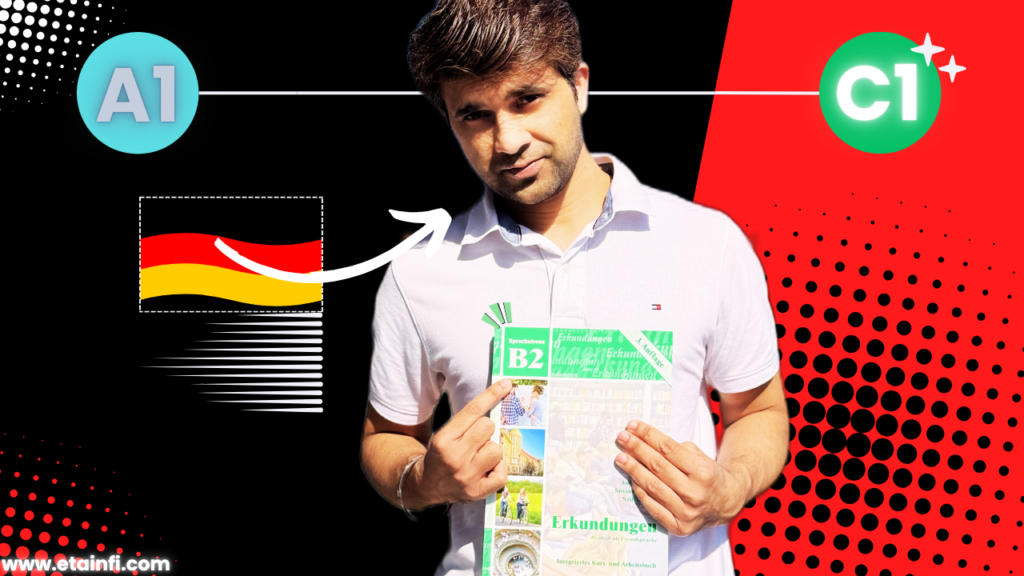
Learning German can be a rewarding journey, opening doors to a rich culture, thriving job markets, and intellectual pursuits. This comprehensive guide provides expert advice on resources, methods, and study plans for learners at every proficiency level, from A1 to C1. Whether you’re just starting out or aiming for advanced fluency, this blog post offers practical tips to guide you every step of the way.
Where Do I Start Learning German (A1 Level)?
For beginners, keeping things simple is essential. Stick to one or two resources to build a strong foundation without feeling overwhelmed. A great starting point is Nico’s Weg, a free online course by Deutsche Welle, featuring short videos, exercises, and grammar breakdowns tailored for new learners. To make the most of it, try rewriting video scripts and reviewing vocabulary lists—repetition helps solidify the basics.
For interactive learning, Lingoda offers private or small group lessons with native-speaking teachers, covering practical topics like ordering coffee or introducing yourself. Its flexible scheduling suits busy lifestyles, and the Sprint Challenge—a daily lesson for 60 days—can fast-track progress to A1.2, often with cashback incentives. Tools like Anki (try the Goethe Deck A1-B1) are perfect for vocabulary, while Reverso helps with conjugation practice. Aim to learn 10-20 words daily and save verbs for later review.
Two-Hour Study Plan for A1:
- 1 hour: Nico’s Weg or Lingoda lesson
- 30 minutes: Anki vocabulary
- 30 minutes: Reverso conjugation exercises
How Can I Build Confidence at A2 Level?
At A2, it’s time to deepen your skills. Continue with Nico’s Weg or Lingoda for structure, but add Grammatik Aktiv A1-B1 for grammar practice. This book combines exercises across levels, reinforcing A1 while preparing you for B1. For pronunciation, Narichtenleicht provides slow-speed news audio with transcripts—perfect for shadowing. Repeat after the speaker to boost fluency and listening skills.
Immersion becomes key here. Tune into Easy German on YouTube for engaging topics and everyday phrases, or try their podcast for cultural insights. Deutsch Podcast offers level-specific grammar lessons—listen during downtime to increase exposure. Don’t stress about understanding everything; focus on surrounding yourself with German.
Two-Hour Study Plan for A2:
- 1 hour: Nico’s Weg or Lingoda
- 30 minutes: Grammatik Aktiv exercises
- 30 minutes: Shadowing with Narichtenleicht
Enhancing Your German with a Video Tutorial
To complement the resources and strategies in this guide, a video tutorial has been created to support your German learning journey. This video highlights key methods and tools, offering visual and auditory examples to reinforce the material. Whether you’re a visual learner or prefer step-by-step guidance, this resource provides an engaging way to accelerate your progress. Check it out to enrich your study routine and see these tips in action.
What Steps Take Me to Intermediate B1 Level?
Reaching B1 requires stepping up your game. Move beyond Nico’s Weg and Lingoda by trying News in Slow German at 1-1.5 speed. Pair it with the Easy German Podcast—listen with transcripts first, then without, to build vocabulary. Explore Deutsche Welle’s podcasts like Das sagt man so and Deutsche im Alltag, or unwind with audiobooks (Hörbuch on YouTube) before bed.
Start thinking and speaking in German daily. This simple habit—talking to yourself about everyday topics—can level up with a tandem partner. Discuss books or movies to stretch your skills. Watching German vlogs with subtitles also sharpens comprehension.
Two-Hour Study Plan for B1:
- 1 hour: News in Slow German or Easy German Podcast
- 30 minutes: Speaking practice (self-talk or tandem)
- 30 minutes: Vlog watching with subtitles
How Do I Break Through to Advanced B2-C1 Levels?
Reaching B2-C1 is a major achievement! At this stage, immersion trumps rote study. Use Grammatik Aktiv B2-C1 for grammar, but focus on real-world exposure. For everyday German, watch movies and series—documentaries are highly recommended. For academic or professional fluency, try ZDF Heute Nachrichten, Tagesschau, or ARTE documentaries. Mr. Wissen to go Geschichte is a gem for history buffs.
Podcasts like Lanz und Precht (politics) and Soziopod (sociology) cater to specialized interests—find ones in your field. On Instagram, follow Tagesschau and Spiegelmagazin for quick news bites. Reading German newspapers aloud, even a page daily, builds fluency. Stay consistent—routine overcomes plateaus.
Two-Hour Study Plan for B2-C1:
- 1 hour: Media immersion (movies, news, podcasts)
- 30 minutes: Grammatik Aktiv exercises
- 30 minutes: Reading aloud (newspapers or articles)
What Does a Winning Study Plan Look Like?
The two-hour plans adapt to each level, balancing listening, speaking, reading, writing, grammar, and vocabulary. Beginners prioritize structure (Nico’s Weg, Lingoda), intermediates add complexity (News in Slow German), and advanced learners embrace immersion (Tagesschau, movies). Customize these plans to your goals—consistency, not perfection, fuels success.
Final Thoughts: Your Path to German Mastery
Fluency in German is achievable with the right tools and mindset. From Anki flashcards to Lingoda sprints, Easy German podcasts to Tagesschau news, these resources span every level. Stay patient, immerse daily, and tackle challenges—your skills will grow steadily. For more personalized guidance, ETAINFI is ready to assist. Start now, and soon you’ll be speaking German with confidence!


